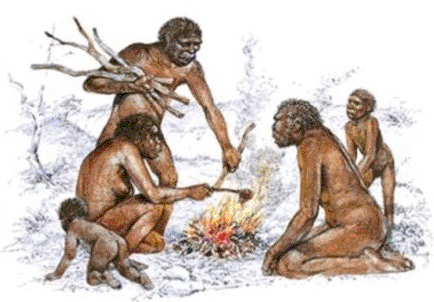




Archaic Humans
2.8 million years ago: Homo habilis, an ancestor of Homo sapiens lived.
400,000 y.a. __The Proto-Neanderthals split into two groups during the severe Saale ice age.
Intelligence of the Archaic humans: Homo erectus is estimated to have had an IQ of between 50 and 60, based on brain size and on tool making abilities. Modern humans have an IQ around 100. Over the past 2,000,000 years, we have gained 40 points. That is about 1 point each 50,000 years. That means we are only 6 points smarter than Neanderthals, only 4 points smarter than the Omo people - the first AMH - and only one single point smarter than the Cro-Magnons. A difference that small is very hard to measure.
Homo habilis developed the Oldowan technology for making stone tools. Habilis lived in Africa and was possibly descended from Australopithecus africanus or A. garhi.1.9 million years ago: Homo erectus (1.9�0.07 Ma) emerged in Africa and spread widely.
He was an ancestor of Homo sapiens. This was a very successful creature surviving for almost 2 million years over a broad range in Asia (Java Man, Peking Man), Europe, and Africa until as recently as 70,000 years ago. That date suggests the Mt. Toba eruption may have caused the demise of the Erectus.800,000 y.a. __Footprints left by H. antecessor
Descendants of Homo habilis
• H. habilis (2.8�1.5 Ma),
• H. erectus (1.9�0.7 Ma),
• H. ergaster (1.9�1.3 Ma),
• H. rudolphensis (1.9 Ma),
• H. gautengensis (1.9�0.6 Ma),
• H. georgicus (1.8 Ma),
• H. antecessor (1.2�0.8 Ma),
• H. heidelburgensis (0.7�0.2 Ma),
• H. denisova (0.6�0.075 Ma),
• H. neanderthalensis (0.5-.025 Ma),
• H. rhodesiensis (0.4�0.12 Ma),
• H. sapiens (0.4 Ma - present),
and
• Anatomically Modern Humans, (0.27 Ma)
Undoubtedly there were many more.
Erectus developed the Acheulian stone tool technology and used it for about 1.7 million years. They used spoken language and the ability to use fire. They had dark hairless skin, rich in melanin, and abundant sweat glands that evolved about 1.2 million years ago to regulate body temperature.
Footprints left by a group of people, including several children and one adult male, have been found at Happisburgh on the coast of Norfolk, England.700,000 y.a. __Homo heidelbergensis
Heidelburg Man emerged in Europe from500,000 y.a. __Proto-Neanderthals branched off from H. heidelburgensis in the Middle East.
H. erectus. Heidelburgensis lived in a wide range across Europe from England to Asia and into Africa where a more recent form is known as H. rhodesiensis. Modern man emerged in Africa, so our ancestor was
H. rhodesiensis. The European H. heidelburgensis developed the Mousterian technology that was later used by the Neanderthals who then taught it to the early
Cro-Magnons after they arrived in Europe. (Modern science holds that H. heidelburgensis and H. rhodesiensis are the same. The two names are geographical and do not refer to different species.)
400,000 y.a. __The Proto-Neanderthals split into two groups during the severe Saale ice age.
The western group became the Neanderthals who later shared Europe with, and learned the Mousterian stone tool technology from, Heidelburgensis. The eastern group migrated into Asia where they became the Denisovans.270,000 y.a. __Perry's DNA suggests modern humans were emerging 270,000 years ago
This discovery has caused the geneticists to assign new names to the early haplogroups. Haplogroup A used to be the oldest, but now A00, A0-T, and A0 have been added to accommodate the Perry findings. Haplogroup A00 probably developed from Rhodesiensis which is the same as Heidelburgensis.
Intelligence of the Archaic humans: Homo erectus is estimated to have had an IQ of between 50 and 60, based on brain size and on tool making abilities. Modern humans have an IQ around 100. Over the past 2,000,000 years, we have gained 40 points. That is about 1 point each 50,000 years. That means we are only 6 points smarter than Neanderthals, only 4 points smarter than the Omo people - the first AMH - and only one single point smarter than the Cro-Magnons. A difference that small is very hard to measure.
